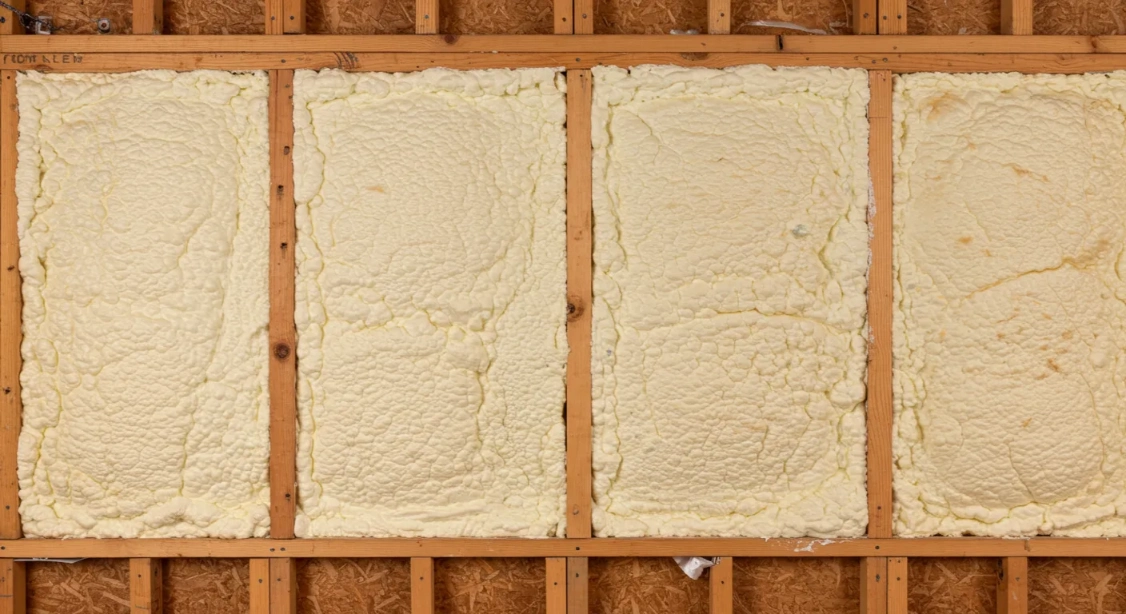R-value measures insulation’s resistance to heat flow. A higher R-value means better thermal resistance. When selecting spray foam insulation, R-value directly affects energy efficiency, HVAC load, and long-term performance.
Open-cell and closed-cell spray foam differ in R-values, with closed-cell offering a higher rating per inch. However, choosing the right type involves more than the R-value alone. Climate conditions, building envelope requirements, and moisture control also influence the decision. This article explains how R-value impacts performance, compares spray foam types, and offers insights from real-world insulation installations.
Stellrr Insulation & Spray Foam shares field experience based on Central Texas projects where precise R-value targeting significantly reduced energy bills and improved indoor air stability in both residential and commercial settings.
R-Value Basics Explained
| Insulation Type | R-Value per Inch | Water Resistance | Air Seal Quality | Density | Typical Use Cases |
|---|---|---|---|---|---|
| Open-Cell Spray Foam | R-3.5 to R-3.8 | Low | High | ~0.5 lb/ft³ | Interior walls, soundproofing, attics |
| Closed-Cell Spray Foam | R-6.0 to R-7.5 | High | Very High | ~2.0 lb/ft³ | Crawl spaces, basements, exterior walls |
Bonus Tip: For humid zones like Central Texas, closed-cell foam offers additional moisture protection that reduces mold risk in crawl spaces and rim joists.
Why R-Value Alone Isn’t Enough
High R-value does not always mean better results. Real-world thermal performance depends on proper installation, coverage continuity, and how insulation interacts with other building materials. Thermal bridging, air gaps, or improper application reduce actual efficiency even if R-value is high.
Technical Specification Table:
| Factor | Description |
|---|---|
| R-Value | Measures thermal resistance (higher is better) |
| Thermal Bridging | Heat transfer through structural elements |
| Air Leakage | Gaps that allow conditioned air to escape |
| Vapor Permeability | Moisture flow through materials |
| Compression or Voids | Reduces insulation performance |
Bonus Tip: In spray foam installations, consistency of depth is more critical than the nominal R-value. One uneven section can create performance gaps.
How Regional Climate Affects R-Value Needs
In Central Texas, high summer temperatures and humidity make heat gain a major concern. Proper R-values can help reduce attic temperatures by up to 30°F, decreasing HVAC cycling and extending system lifespan.
The U.S. Department of Energy recommends R-38 for attics and R-13 to R-21 for walls in Zone 2, which includes Austin and surrounding areas (Source: Energy.gov).
Things to Consider Before Making a Decision
- Installation Depth: Know how thick the foam must be to reach the desired R-value.
- Vapor Barrier Needs: Closed-cell foam can act as a vapor barrier, open-cell cannot.
- Structural Reinforcement: Closed-cell adds strength to walls; open-cell does not.
- Budget Constraints: Closed-cell is more expensive per inch but may require less space.
- Code Compliance: Check local codes for minimum R-value and fire safety requirements.
Bonus Tip: In retrofits, insulation removal may be needed to ensure full adhesion and accurate R-value delivery. Avoid applying foam over compromised materials.
Practical Comparison of Spray Foam Types
| Feature | Open-Cell Spray Foam | Closed-Cell Spray Foam |
|---|---|---|
| R-Value per Inch | R-3.5 to R-3.8 | R-6.0 to R-7.5 |
| Moisture Resistance | Low | High |
| Air Seal | Strong | Superior |
| Cost per Board Foot | Lower | Higher |
| Application Areas | Interior, sound control | Exterior, moisture-prone areas |
| Vapor Barrier | No | Yes |
| Structural Strength | No | Yes |

Services for Effective Insulation Performance
Stellrr Insulation & Spray Foam provides core services focused on energy efficiency and structural integrity:
- Closed Cell Insulation: Offers high R-values and vapor barrier protection in one application.
- Open Cell Insulation: Ideal for interior walls and sound control in conditioned spaces.
- Attic Insulation: Custom installation plans to meet DOE-recommended R-38 levels.
- Insulation Removal: Removes old or damaged insulation to prepare surfaces for proper R-value delivery.
Common Questions Before Choosing Spray Foam Insulation
How many inches of spray foam do I need?
For R-38 in attics using closed-cell, 6 inches is typical. For open-cell, around 10.5 to 11 inches is needed.
Can I mix insulation types?
Yes, but the layering must follow vapor management principles. Avoid trapping moisture.
Is spray foam safe for indoor use?
Once cured, spray foam is inert. Ensure proper ventilation during installation.
Does higher R-value always equal better insulation?
No. Poor application, compression, or thermal bridging can nullify high R-values.
Get Expert Insulation Guidance
Need precise guidance on spray foam R-values for your home or building? Stellrr Insulation & Spray Foam delivers field-proven solutions based on real performance data, not assumptions.
Contact: Phone: (512) 710-2839 Email:info@stellrr.com
FAQ
What happens if spray foam R-value is too low?
The building may lose heat in winter or gain heat in summer, increasing HVAC usage and energy costs.
Can spray foam insulation fail over time?
If installed properly, it remains effective for decades. Failures typically result from moisture issues or poor application.
Is there a minimum R-value required by code in Central Texas?
Yes. Codes often require R-38 in attics and R-13 to R-21 in walls, depending on the building type.
How does spray foam compare to fiberglass in R-value?
Spray foam has a higher R-value per inch and provides air sealing, unlike fiberglass.
Does thicker spray foam always mean better results?
Only up to a point. Beyond target R-values, gains become minimal and may waste material.

